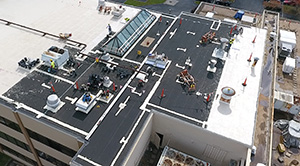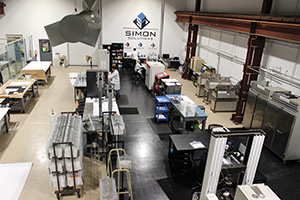How extending the useful life of a commercial roof has become a science.
By Anthony Vross
We’ve come a long way from the days of hot-applied coal tar and asphalt. The commercial roofing industry has become highly technical, both in the way materials are designed and installed, as well as how roofs are maintained to extend their useful life.
Today there’s a true scientific approach to commercial roofing that involves innovative software and sophisticated testing, as well as a considerable amount of research, data analysis and predictive modeling. Facility managers/owners who are buying into these modern best practices are likely to realize significant savings in life-cycle costs and budget dollars.
 The Birth of the Modern Roof
The Birth of the Modern Roof
Interestingly, roofing innovation and science can be traced back to the World War II era. It was then when synthetic rubber was first developed in response to the United States’ access to natural rubber in Southeast Asia being cut off at the beginning of the war.
In response, the U.S. government formed a consortium of rubber research and production companies to quickly develop a general-purpose synthetic rubber to use in war efforts — from tires for military vehicles, planes and tanks, to use in footwear and equipment for soldiers.
According to the American Chemical Society, the U.S. was using half the world’s supply of natural rubber at the time, most of it coming from Southeast Asia. Losing access to this essential feedstock could prove catastrophic.
While the consortium’s efforts were highly successful in meeting the war-related demands and timelines, a byproduct of their work was the huge step it made in advancing synthetic rubber technology. New knowledge was gained about the polymerization process, production, efficiency and quality control, and scientists gained a better overall understanding about the chemical structure of rubber, which proved to kick start new applications in several other industries, including roofing.
There’s an unmistakable link between the tire industry and roofing industry. The synthetic rubber technology first applied to the tire industry post-World War II ultimately was determined to be effective in commercial roofing. Early innovations literally were the same material, just extracted differently. But later on, and into today, roofing materials have gotten more customized to specific building types and climates.
Using Science to Develop New Materials
New materials continue to develop and improve today across the industry. Further, we’re considering how different chemical formulations react in various climates and in combinations with various membranes and building types; all to reduce or eliminate leaks and UV damage, and extend a roof’s useful life.
Sophisticated laboratory testing is being conducted to evaluate performance and wear characteristics on new materials, and how they withstand ultraviolet rays, flying debris, high wind speeds and exposure to water.
The industry is in a constant battle to eliminate failure points in roofing systems, and science is playing a leading role in this fight. Seamless roofs, saturated reinforcements and field-applied coatings have all led to improvements in both performance and durability.
Using Science to Assess a Roof’s Current Condition and Depletion Rate
The growing sophistication of core sample testing and iterative software has led to major advances in assessing a roof’s current condition. Incorporating science and technology to the testing and evaluation stage of roofing inspections removes the subjectivity and varying degrees of quality you’d get based on the experience level of the technician performing the inspection.
 Today’s core sample testing of membranes goes far beyond traditional visual and infrared analyses to calculate a roof’s service life expectancy and depletion rate. It may include ISO-certified labs with documented sample protocol handling, as well as state-of-the-art equipment that accurately measures certain relevant properties through mechanical and chemical testing. It can then take a comparison of the findings against years and years of analytical data. Using multiple data points beyond a simple, subjective visual inspection can provide facility owners/managers with a more accurate and objective determination of a roof’s remaining useful life and offer the smartest courses of action to extend it even further.
Today’s core sample testing of membranes goes far beyond traditional visual and infrared analyses to calculate a roof’s service life expectancy and depletion rate. It may include ISO-certified labs with documented sample protocol handling, as well as state-of-the-art equipment that accurately measures certain relevant properties through mechanical and chemical testing. It can then take a comparison of the findings against years and years of analytical data. Using multiple data points beyond a simple, subjective visual inspection can provide facility owners/managers with a more accurate and objective determination of a roof’s remaining useful life and offer the smartest courses of action to extend it even further.
Far too often, building owners and facility managers without the extensive scientific data end up resorting to costly replacements for problematic roofs that really have years of life still remaining. The more reliable the information at hand, the better equipped a facility owner/manager can be with planning efficient and cost-effective roofing maintenance for years to come.
Using Science to Properly Time Interventions
Re-roof alternatives are proven to be significantly more cost effective than running the roof to failure and then replacing it. Using today’s available technology and re-roof alternatives, building owners and facility managers can make objective roofing decisions based upon scientific testing and analysis — and eliminate the risk of making reactive decisions based solely on speculation and inexperience.
— Anthony Vross is a co-owner of Simon Roofing, a national commercial roofing installer/manufacturer that’s among the largest roofing contractors in the United States.
